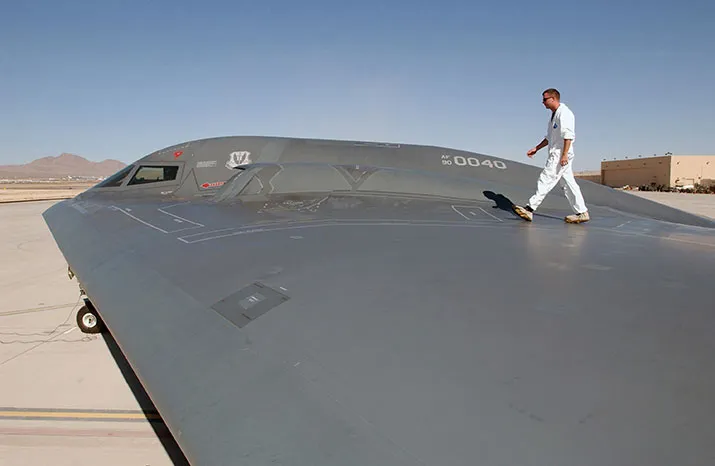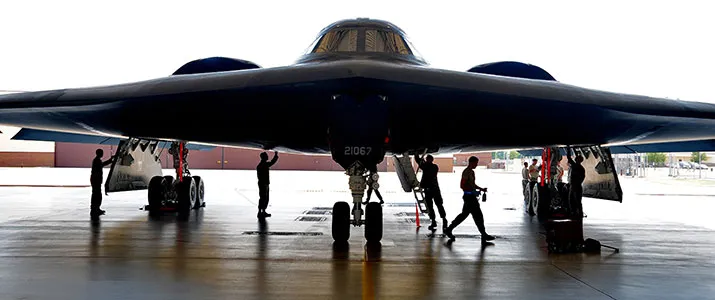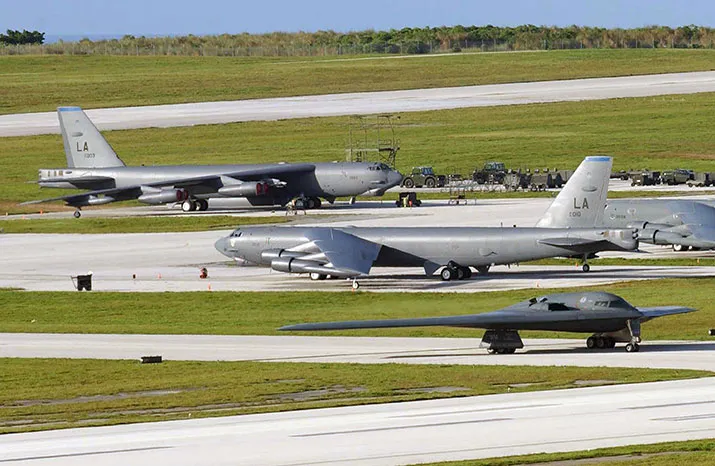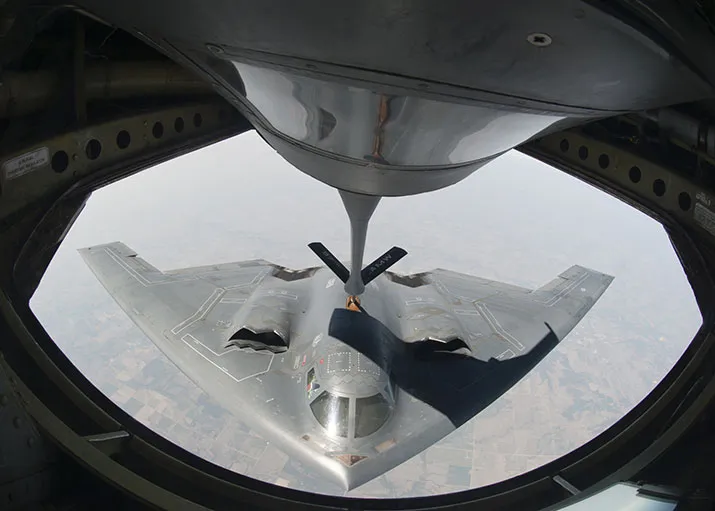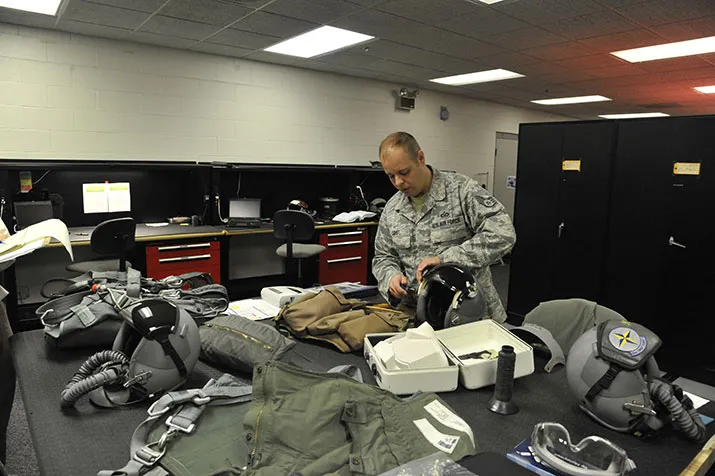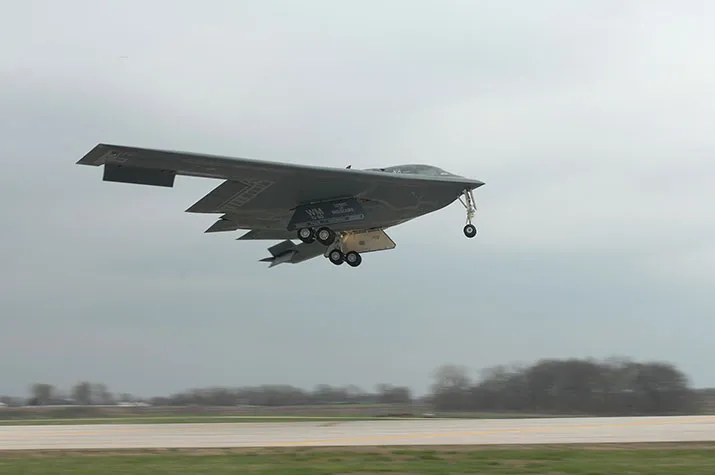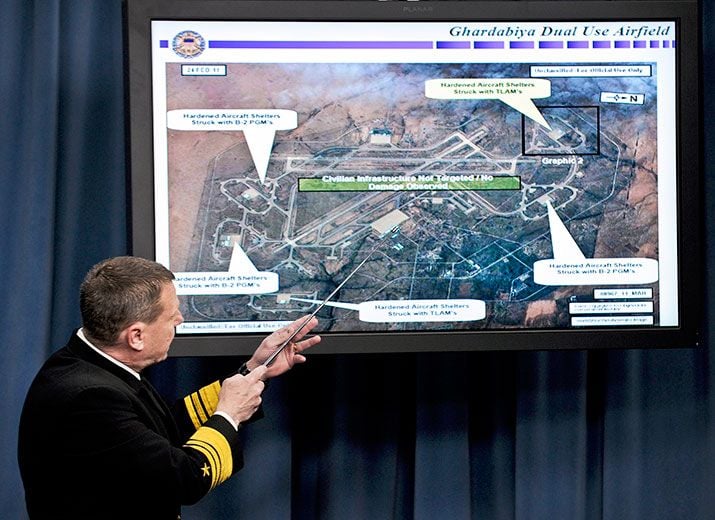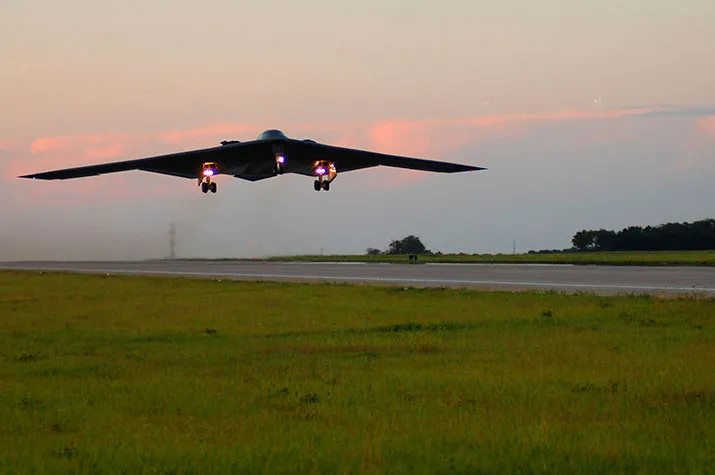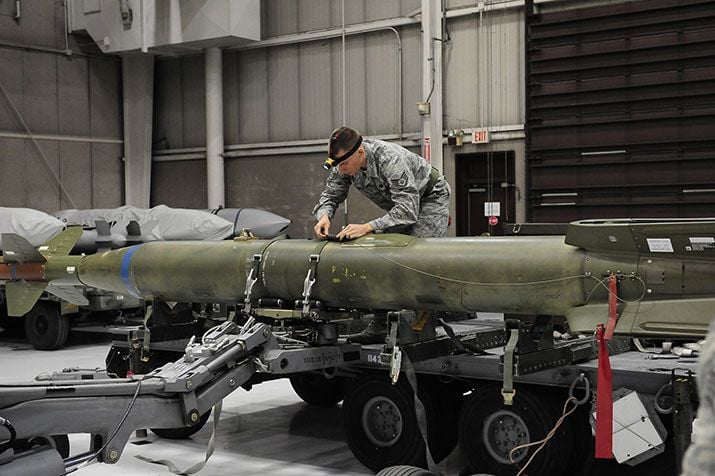The Stealth Bomber Elite
Fewer than 100 pilots climb the ladder to the B-2 cockpit
/https://tf-cmsv2-smithsonianmag-media.s3.amazonaws.com/filer/f6/34/f634cd4a-3de5-4fb4-814f-dc58e3ccaf04/stealth-pilots-billboard.jpg)
“Undetected inbound, unscathed outbound.” That’s how one pilot summarized his mission to bomb targets in Baghdad with the $2.2 billion Northrop Grumman B-2 Spirit on the first night of Operation Iraqi Freedom in March 2003. His words capture the reasons the Air Force built such an expensive bomber to launch global-strike missions, which B-2 pilots fly from Whiteman Air Force Base in central Missouri. Twenty years after the first mysterious bomber arrived at Whiteman, the B-2 still stands ready to deter bad behavior, hearten allies, and destroy targets “anytime, anywhere,” as Whiteman’s 509th Bomb Wing puts it.
“Unless a nation has the technological prowess and the wealth to build stealth aircraft, hitting targets in well-defended lands takes a lot of air power. America’s last big air action without stealth was Linebacker II, late in the Vietnam War, which sought to bomb the North Vietnamese back to the peace table. Daily attacks to protect a 70-mile-long column of B-52s required up to four dozen support aircraft at a time to jam, blind, and destroy surface-to-air-directing radars. Even so, over the 11-day operation, waves of Soviet-built missiles shot down 27 aircraft.
“That was in 1972. Two decades later, the B-2 Spirit of Missouri touched down at Whiteman, the first stealth bomber of 22 to be delivered. Today, the fleet has served in four wars: Kosovo (1999), Afghanistan (2001), Iraq (2003), and Libya (2011). After 20 years of service—the Air Force is planning a celebration at Whiteman in late September—the B-2 is a different bomber than the ones pilots flew on their first training missions.
“Early in the aircraft’s history, a pilot (who asked for anonymity) told me: “When I first came in 1995, the wing commander walked them out of the dock and there was a fire truck ready. And before every flight, the commander personally briefed the wing commander. There were two takeoffs a week total. Now the crew chief walks them out and we do six to seven flights a day. The system has matured. It doesn’t have the weaknesses it had before.”
“Standing in Dock 12 alongside the Spirit of South Carolina—each bomber is commissioned with a state’s name—I don’t notice any change. The B-2 still appears to be a shape-shifter, an optical illusion. From some angles, the bomber looks as compact as a business jet and without nearly enough interior space to carry 30 tons of bombs, but the maintainers who met me there on a Friday afternoon last May assure me it has the wingspan of a B-52, though the fuselage is only as long as an F-15 fighter’s.
“But there have been upgrades. Its stealthy skin is now easier to maintain, and the time spent on maintenance per flight hour has been cut in half. Its radar and communications have been improved. Since 1993, new precision-guided weapons have been added to the quiver, and more are on the way, including a nuclear-tipped cruise missile.
“Pilots are one hard limit that upgrades can’t change. But almost two decades of experience can. The learning began in early 1999, when the B-2 first went into combat over the former Yugoslavia. That’s the year that then-Major “Pita” joined the ranks. (To protect identities, the 509th Bomb Wing requested that I use only the pilots’ call signs.) Pita had been flying F-16 fighters for seven years at bases in Japan and the United States. The Air Force selects B-2 pilots from both fighter and bomber camps. The philosophy is that the autonomy and adaptability of the former complements the team-oriented steadiness of the latter. Even for highly experienced pilots, acceptance into the B-2 corps usually takes a year.
““It’s not just the credentials and your proficiency when flying,” Pita tells me. “The pilots have a say as well,” because the missions are long (the longest combat mission for the B-2 has been 44.3 hours) and require close coordination between pilot in the left seat and mission commander in the right. “If they feel a pilot would make them uncomfortable, or is unpleasant to be around, that’s important [to know],” Pita says.
“After being accepted into the wing, Pita started the B-2 training in October 1999. New pilots master the T-38, an agile, twin-seat jet trainer that keeps skills and reactions sharp, and they must complete an initial qualification training (IQT) course covering fundamental B-2 skills. Each IQT class holds just three or four trainees; classes graduate in six or seven months.
“After Pita was inducted into the 325th Squadron, his training shifted from methods to missions. Then fully qualified, Pita served as an instructor, pending the chance to fly the bomber into combat. That came in March 2003, as the United States made final preparations to oust Saddam Hussein.
““We had an impending sense that something was going to happen,” he says. This was confirmed by a series of summons over a period of days: Study intelligence briefs; adjust work schedules for a long mission. Over at the weapons storage area, loaders were mating bombs with JDAM (Joint Direct Attack Munitions) guidance packages, then toting the one-ton bombs into the docks for loading. A day before the flight, crews studied the combat mission folder (a binder about two inches thick) and rehearsed in the simulator.
“After the final—mandatory—crew rest period, it was launch day. If the pilots lived off base, in Warrensburg or Sedalia, their family members dropped them off at the base, stretching out family time a little more. At home, each family had an envelope of personal thoughts from the pilot marked for opening in case of mishap.
“Airmen loaded the gear that Pita and mission commander “Spaghetti” would need in the airplane: a sleeping bag, extra clothes, survival kit, folding cot, snacks and sandwiches, bottled water, plenty of piddle packs to avoid overfilling the toilet bowl, and lots of Diet Cokes for Pita.
“Across the ramp, maintainers and preflight crews were checking the aircraft, verifying that the bombs were talking to the computers, and preparing to start the engines well ahead of the crew’s arrival.
“Downstairs in the Mission Planning Cell, Pita and other pilots in the initial wave of B-2s bound for Baghdad heard final briefings, which alternated between small groups and all pilots. Each two-pilot crew also worked with a lead mission planner: “We looked over the situation and threats that might arise en route, including the Blue Line and weapons on board,” says Pita.
“The Blue Line is a key part of stealth tactics, and tactics are just as vital as the airplane’s design and the secret materials that reduce its radar cross-section. Uniquely crafted for each mission, the Blue Line stitches the assigned targets onto a flight path calculated to avoid the most dangerous enemy defenses. Pico, a pilot who flew in both Iraq and Kosovo, says that surviving a mission depends on intense planning before takeoff.
“After the briefings, it was time to “step out to the jet,” the Air Force way of saying that all preparations were complete (the pilots “stepped out” via vehicles). On Pita and Spaghetti’s arrival, the dock doors were open and computers and engines were running. It was time to go.
“One of the first jobs pilots have when heading off to war from Whiteman is to stay in touch with civilian air traffic control, all the way to the war zone. Stealthiness creates a risk of a midair collision with a civilian aircraft. The B-2 carries deployable radio antennas for navigation in civilian skies, along with strobe lights for visibility. All such gear retracts when the airplane “stealths up.”
Another thing B-2 crews do on the way to war is gulp fuel, taking up to 50 tons at a time in midair refueling sessions that last a half-hour or more. Flying to Iraq and back takes 38 hours, requiring at least four fill-ups by KC-135 or KC-10 tankers. When the airplane is at its ideal cruising altitude, refuelings take place about every six hours.
“Refuelings are entirely manual; depending on conditions like turbulence and clouds, they can be edgy, so both pilots must be awake and in their seats. Otherwise, when far out over the Atlantic, only one pilot need be in front. Did Pita and Spaghetti use crossword puzzles or games to stay alert, as (reportedly) some pilots have done? Pita says no: “There’s plenty to do, plenty to watch over while you’re in the seat. And if you’re not doing something, then you should be resting.”
“Rest isn’t always easy, particularly before a mission. The space behind the seats, about four feet wide by six feet long, is cramped and noisy. Still, rest is vital, Pita tells me. Standard equipment on every long-duration mission is a folding Army cot customized to fit the B-2’s floor space. It’s an official upgrade from the Walmart lawn chairs that some crews bought during the Kosovo war. “But the way you set it up was more of a pain,” Pita says, “so I just put my sleeping bag on the floor.”
“The close connection between crew rest and maintaining alertness during the B-2’s long missions was an important lesson from months of air operations over Kosovo. “We heard after Kosovo—anecdotally—that the pilots were so keyed up they couldn’t sleep,” says Pita. “Then after the adrenaline drained away, once they were off the target, they were exhausted. After that, we gathered some of the best experts on the subject and hosted a symposium at Whiteman. These were experts in sports medicine, nutritionists, some pretty famous.” In her book The B-2 Goes to War, Rebecca Grant recounts that during a post-strike refueling, one B-2 pilot felt he was so close to falling asleep at the stick that he asked the other pilot to take over.
“After a second refueling, over the Mediterranean, pilots heading for Iraq changed into desert-tan camouflage uniforms without name badges and donned survival vests. The vests would offer a backup to a larger survival kit that ejected along with the pilots.
“Pita declines to go into details, but according to other sources, preparing a B-2 for battle includes arming the bombs; climbing to combat altitude (which is classified); turning on ground-mapping radar so that as the airplane approaches the target area, the pilots can refine targeting coordinates; and, of course, “stealthing up.” As far as air traffic controllers could tell, somewhere outside the Iraqi border, Pita’s airplane vanished into the thin night air. Though they could catch brief glimpses of the airplane in action (such as when the bomb bay doors were open), enemy operators of surface-to-air missiles could not lock on. Throughout the Iraq war (and all other B-2 combat engagements), no missiles were launched at the bomber.
“Asked to compare flying F-16s to the B-2, Pita says the F-16 is more physically demanding, but B-2 combat missions leave the pilots exhausted: “There’s so much going on. The biggest challenge comes when you have to deviate from the plan. We build that into the training so when the shit hits the fan, [new pilots] can cope. So it’s not the first time they’ve seen something like that. But [during training], the worst impact was just me yelling at them.”
“When glitches arise during non-critical phases, it’s important that the pilot be trained enough, and confident enough, to work through them himself, says Pita. Or herself, given that the B-2 cadre includes three female pilots. (The total number of B-2 pilots is classified, but I have been told it’s about 80.) For example, if the other pilot is in the middle of a four-hour nap, it’s bad form to wake him without good reason. “When you’re halfway around the world and the other is in rest, and something comes up, you should be able to work it yourself,” Pita says. “It’s his time to rest.”
“For a second opinion on lessons from past operations, I spend an hour in the Mission Planning Cell with Pico. A lieutenant colonel, Pico transferred into the program from B-52s. He flew the B-2 in the Iraqi war, and accumulated 1,000 hours in it. He also has flown an extreme-duration mission in the simulator: 50 hours.
“Pico emphasizes that while the image of the B-2 may be that of a lone ranger, going into enemy territory alone and unafraid, it wouldn’t get far without support from a few non-stealthy aircraft: tankers from Air Mobility Command, B-52s that knock out radar-control centers, and support aircraft that jam enemy radar and blow it up with anti-radiation missiles. But that’s far less support than was needed in Vietnam, when one Linebacker II mission saw 60 B-52s accompanied by 101 support aircraft.
“Pico goes on to summarize upgrades to the airplane’s electronics suite and explains how the need arose. For one thing, he says, experiences from Kosovo through Iraq showed the need for better satellite communications. In 1999, messages went back and forth over high-frequency radio in the form of sparsely worded text, which could be retyped into the system to change targets in flight. After Kosovo, the Air Force fitted a laptop to each B-2 to provide an interface more like email, but that wasn’t the perfect solution either. He describes a mission in which he had closed his laptop before going into the combat zone, then heard from another B-2 crew nearby that he should refresh his messages because a late-breaking update on the target list had just come over the network. “If I hadn’t checked, we would have dropped just three bombs out of 16; the message added four more.”
“It was during Kosovo that the B-2 wing encountered its greatest challenges. That combat required the most lengthy and sustained operations (78 days), and the Slobodan Milosevic territory held the most dangerous anti-aircraft weapons. Serbian gunners had learned from Iraqi veterans of the 1991 Gulf war about using their radar and missiles to maximum effect, and how to avoid being destroyed by anti-radar missiles.
“According to the pilots I’ve spoken with, combat lessons and improved technology have made the B-2 more capable than ever, but the job of flying it is no easier. Additions over the last decade enable the airplane to gather and transmit information about the battlespace, taking advantage of the fact that the B-2 is the only manned platform that can fly where enemy radar and surface-to-air-missile defenses are up and running. Part of the B-2’s mission is mapping the state of the enemy’s air defense system by getting the enemy to turn on radars and missile batteries, especially on Night One.
““We’re constantly upgrading the system and avionics,” says Brigadier General Thomas Bussiere, a B-2 pilot who directed operations over Kosovo and is now commander of the 509th. “The pilots have weapon systems to manage already, and we put this [new equipment for intelligence, surveillance, and reconnaissance] on their shoulders too—and for a 36- to 38-hour mission. They’ve been transformed from stick-and-rudder pilots to system operators.”
“Bussiere encourages me to meet the supporting cast at Whiteman. “This is a $2.2 billion national asset, but it’s a static display without the airmen,” he says. “Every one of them is critical. We tend to concentrate on the two in the cockpit, but they stand on the shoulders of thousands of airmen.”
“That would be people like Airman Sergeant Andrew Jones and Airman John Hodge, who take time on a Friday afternoon to walk me around Dock 12 and its resident, Spirit of South Carolina. Hodge has dropped in from another dock to show me around; he’s the crew chief for Spirit of Ohio, one of two B-2s that flew to South Korea last spring for Foal Eagle exercise, a joint U.S.-South Korean exercise.
“Ohio is Hodge’s baby, more so even than the pilots who used it to bomb Libya in 2011, because pilots hop readily from airplane to airplane. Jones is also a plane-hopper, since he specializes in electronic troubleshooting. Those troubles include learning that long-ago parts contractors have gone out of business, and wires with embrittled insulation need replacing. Whiteman shares the wiring restoration work with Air Force Plant 42 in Palmdale, California, where the B-2s go for a complete overhaul at seven-year intervals. At any given time, three or four B-2s are at Palmdale and not “combat coded.”
“Jones points out dark gray screws that line one panel over our heads. These are stealthy screws, he says: “There’s a book just on how to remove ’em.” In all, a B-2 mechanic’s bookshelf holds more than 1,000 Technical Orders; according to Hodge, a typical job requires pulling out 10 books, whose cross-referenced directions must be followed exactly.
“Hodge shows me the small, diamond-shaped panels in the wing, into which antennas and navigational lights retract whenever the airplane goes dark. The airplane carries no pitot tubes (too obvious on radar); to check airspeed, the pilots use static ports set flush into the skin.
“In time of war, inattention to tiny dents and dings—a bird strike on a leading edge, a misfitted panel—could give the whole show away. A tight fit between the skin and the hatches is so important to stealth that the edges of those doors are like machete blades (see “Applied Stealth,” How Things Work, p. 44). One of the first jobs of a maintainer after parking the aircraft is to slip red plastic guards on the landing gear and bomb bay doors, like knife sheaths.
“Hail, birds, and barely visible defects: All are reminders that what Rebecca Grant calls the “stealth game” is a matter not of inches but of millimeters. Technicians care for their exotic charges with exquisite exactness because the newest B-2 is 13 years old, while the Russian radar sets, air defense computers, and supersonic missiles available to any potential adversary are superior to those that existed when the B-2 was designed and tested.
“But the biggest concern for a B-2 pilot over enemy territory is enemy fighters, “because you can’t plan for them,” says Eric Single, who flew the first night over Kosovo. In The B-2 Goes to War, Grant quotes Single: “The worst thing in the world would be to be visually acquired by a fighter, whether by mistake or by design.” At that point, he says, “you are kind of out of luck.” The B-2 carries no defensive weapons.
“On Single’s flight, about a dozen Serb MiG-29s got airborne; NATO fighters shot down two.
And the early, most dangerous stages of a future conflict are likely to call in the B-2 in what pilots call a “no kidding” capacity. For example, the airplane usually finds its way into articles that speculate what the United States might do about nuclear centrifuges buried deep at Fordow, Iran, since it’s the only stealthy aircraft that can carry the 15-ton Massive Ordnance Penetrator, a precision-guided, 30,000-pound “bunker buster” bomb.
““I’m perfectly comfortable in executing missions anywhere in the world,” says Bussiere. Neither Iran’s shootdown of a stealth RQ-170 drone in December 2011 nor talk of late-model Russian anti-aircraft systems in the Middle East have raised concerns among the pilots. Ironically, all major damage so far has originated from unexpected side effects of the program’s own stealth measures: one bomber lost in 2008 due to a crash on takeoff in Guam (when tropical moisture got into a sensor used to calibrate airspeed and altitude), and one nearly lost to an engine fire in 2010 (when fire crews were unable to put foam on the B-2’s buried-in-the-wings engines). The latest casualty is still undergoing repairs, leaving the fleet size at 20.
“Though the B-2 can haul 80 quarter-ton bombs (or a smaller number of heavier bombs), that big a load hasn’t yet been tried in wartime, even in the most recent engagement: three B-2s attacking Libyan airfields on March 19, 2011. (The trio destroyed a series of hardened aircraft shelters near Sirte, a strike that almost completely wiped out Muammar Gaddafi’s air forces.) Along with more advanced situational awareness tools on board, the extra capability such a load would offer might overtax pilots and mission planners.
Senator Patrick Leahy of Vermont once called the B-2 a “flying Fort Knox” (referring to the price of gold at the time). Since the 2008 crash, the bombers have become even more precious and the Air Force is paying for more upgrades: electronics for better survivability in enemy skies, and improvements in carrying out reconnaissance missions.
There will be no more B-2s rolling off the lines from Northrop Grumman, but the two more decades of service now projected for the B-2 should overlap with the next stealth bomber, now being designed: the Long Range Strike Bomber.
The shoulder patch of the 509th reminds me of a mission for which the B-2 was designed, one that we hardly hear discussed anymore. A mailed fist holds nuclear weapons, with a mushroom cloud in the background. (Though other aircraft types are approved to deliver nuclear weapons, only the 509th is authorized to use the symbolic cloud on its unit emblems.) B-2 pilots have helmets that can be given a white face shield with electronic eye shades (giving the wearer the look of a Star Wars storm trooper) to protect the wearer’s vision from a nuclear blast. And if the time comes, the pilots of the 509th will don their helmets, take off from Missouri, and fly a blue line toward the target.
James R. Chiles is the author of The God Machine: From Boomerangs to Black Hawks, a Social History of the Helicopter (Bantam Dell, 2007).
